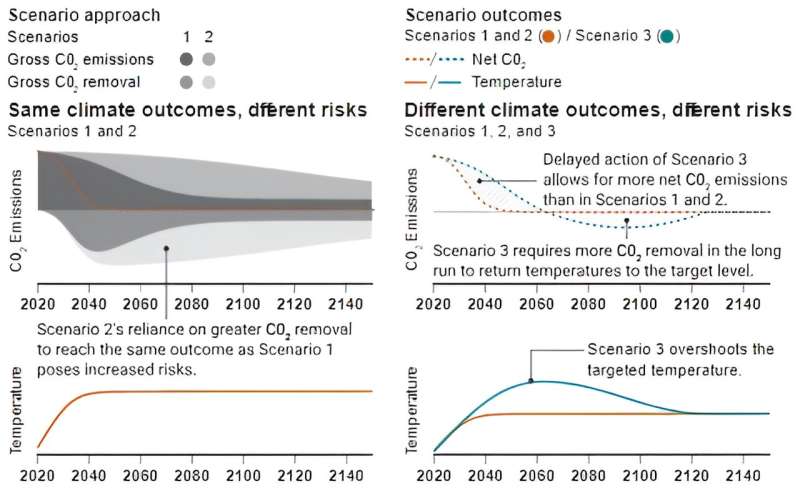
CDR risks and climate outcomes. A given net-emissions pathway (and climate outcome) can result from gross emissions of different levels, balanced by corresponding dependence on different levels of CO2 removal (CDR). For a given climate outcome, greater dependence on CDR to balance larger gross emissions entails additional risks (top two panels). Delayed reductions in net emissions create increased reliance on CDR to remove excess emissions produced in peak-and-decline pathways, resulting in increased climate change impacts during (and for many impacts, after) the temperature overshoot period (bottom two panels). Credit: Science (2023). DOI: 10.1126/science.adi9332
Governments that over-rely on carbon dioxide removal (CDR) to meet their climate targets may be breaching international law, says a new study.
The research team, at the University of Oxford and Imperial College London, are calling for faster cuts in greenhouse gas emissions to limit countries’ dependence on CDR, and warn that they will otherwise risk legal challenges. The study is published today in Science.
To limit the effects of global warming, carbon dioxide (CO2) emissions from human activities must decline to “net zero”—where the amount of CO2 we emit into the atmosphere is equal to the amount we remove from it. To keep within the 1.5° C limit of the 2015 Paris Agreement, many states have drawn up plans that include removing CO2 alongside reducing emissions.
CDR is any process that captures CO2 from the atmosphere and stores it, whether on land, in the ocean, in geological formations, or in products. While some CDR projects have demonstrated progress, the technologies remain in their early stages. Yet the failure of many governments to cut emissions fast enough will leave them heavily reliant on CDR to meet their climate targets. The authors demonstrate how this presents a number of risks, including:
CDR not being deployed at expected levels in the future—a risk amplified by the lack of legally binding commitments to scale up CDR to necessary levelsCO2 removed by CDR leaking back into the atmosphere over timeAn overreliance on CDR in the long term, leading to Paris Agreement targets being temporarily overshot and exposing the world to greater climate change impacts and burdening future generations with retrieving excess emissions from the atmosphere while battling increased climate change impactsSocial, economic and environmental problems, including competition with agriculture for land.
These risks jeopardize the Paris Agreement target, the authors say, and are not in keeping with countries’ commitments to make “fair” and “ambitious” contributions to net zero “in line with the best available science.” Because of this, countries that rely heavily on CDR may not be aligned with the norms and principles of international law.
A costly legacy
Co-author Professor Joeri Rogelj, from the Centre for Environmental Policy and the Grantham Institute at Imperial, said, “Inadequate near-term action creates a long-term dependence on removals. If the emissions leading up to net zero are too high, future generations are handed down a costly legacy that exposes them to additional risks. Without legal guidance and limits on CDR use in climate targets, over-reliance on removals may be the next aspect of climate action failure to be challenged in court.”
Lead author Dr. Rupert Stuart-Smith, from the Oxford Sustainable Law Programme at Oxford’s Smith School, said, “There is no way to meet the Paris Agreement target of limiting global warming to 1.5 degrees without removing some CO2 from the atmosphere.
“However, there is a big difference between pathways to net zero that fail to cut emissions adequately in the near term and leave us with little choice but to retrieve vast quantities of emissions from the atmosphere in subsequent decades, and those that entail steep and immediate cuts in emissions—at least 50% this decade—and do not leave such a heavy cleanup burden for future generations. Policymakers must recognize this point, and failing to act accordingly could see climate targets challenged in the courts.”
More ambitious reductions
The study gives examples of previous court cases they believe have already set a precedent for legal action, including Urgenda Foundation vs. State of the Netherlands, which compelled the Dutch government to reduce emissions by 25%.
Co-author Professor Lavanya Rajamani, from the Law Faculty at Oxford, noted, “States that seek to avoid the hard work of near-term mitigation by relying on extensive removals in future will likely breach the norms and principles of international law. We need to see more ambitious near-term greenhouse gas emission reduction commitments from states, followed by rigorous implementation and robust accountability.”
Co-author Dr. Thom Wetzer, co-author and Associate Professor of Law and Finance and Director of the Oxford Sustainable Law Programme, added, “Climate policies of many countries are incompatible with the Paris Agreement unless vast quantities of CO2 are removed from the atmosphere in the future. As governments head into the COP28 climate negotiations in December, they should focus on near-term actions to reduce emissions rather than promises of future removals, or risk being challenged in court.”
More information:
Rupert F. Stuart-Smith et al, Legal limits to the use of CO2 removal, Science (2023). DOI: 10.1126/science.adi9332
Citation:
Relying too much on carbon dioxide removal is ‘likely inconsistent with international law,’ say researchers (2023, November 16)
retrieved 17 November 2023
from https://phys.org/news/2023-11-carbon-dioxide-inconsistent-international-law.html
This document is subject to copyright. Apart from any fair dealing for the purpose of private study or research, no
part may be reproduced without the written permission. The content is provided for information purposes only.
>>> Read full article>>>
Copyright for syndicated content belongs to the linked Source : Phys.org – https://phys.org/news/2023-11-carbon-dioxide-inconsistent-international-law.html














![[News] Japan Develops 10nm Nanoimprint Technology, with Potential to Tackle EUV Bottleneck – TrendForce](https://earth-news.info/wp-content/uploads/2025/12/329851-news-japan-develops-10nm-nanoimprint-technology-with-potential-to-tackle-euv-bottleneck-trendforce-360x180.jpg)
















